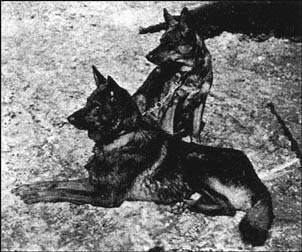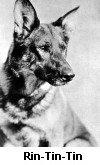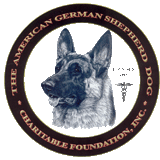
In 1889 Captain Max von Stephanitz began the standardization of the breed. It all started at a dog show in Karlsruhe in western Germany. A medium-sized yellow-and-gray wolflike dog caught his attention. The dog was of the primal canine type, supple and powerful, and possessed endurance, steadiness, and intelligence. He was a working sheepherder, requiring no training other than direction and finish to become proficient at the task. This dog, Hektor Linksrhein, was purchased by von Stephanitz, renamed Horand von Grafrath, and became the first registered German Shepherd Dog.
Von Stephanitz founded the Verein für Deutsche Sch·ferhunde, SV, becoming the first president, and in a short period of time achieved the standardization of form and type in the breed. A standard was developed based on mental stability and utility. The captain’s motto was “Utility and intelligence”. To him beauty was secondary, and a dog was worthless if it lacked the intelligence, temperament, and structural efficiency that would make it a good servant of man. A breed standard was developed as a blueprint dictating the exact function and relationship of every aspect of structure, gait, and inherent attitude.
Von Stephanitz inbred heavily on Horand and also Luchs, his brother, to consolidate the bloodline. Horand’s best son, Hektor von Schwaben, the second German Sieger, was mated with his half-sister as well as through daughters of his own sons, Beowulf, Heinz von Starkenberg, and Pilot III.
Intense inbreeding also concentrated undesirable recessive originating from the mixing of the original strains. Von Stephanitz then inserted unrelated blood of herding origin through Audifax von Grafrath and Adalo von Grafrath.
Mira von Offingen, imported by Otto Gross, was shown by H. Dalrymple, of Port Allegheny, Pennsylvania in the open class at Newcastle and Philadelphia. The first championships awarded German Shepherd Dogs was in 1913.
In 1913 the German Shepherd Dog Club of America was formed by Benjamin Throop and Anne Tracy, with 26 charter members.
The German Shepherd Dog Club of America’s first specialty show was at Greenwich, Connecticut in 1915. In 1917, when America entered World War I, all things German became tabu. The American Kennel Club changed the name of the breed to the Shepherd Dog and the German Shepherd Dog Club of America became the Shepherd Dog Club of America. In England, the name of the breed was changed to the Alsatian.
With the end of World War I came a new appreciation for the breed. The German Army had made good use of the breed as a war dog. Tales told by returning U.S. fighting men, some bringing shepherds with them, and the intelligence and striking appearance of the dogs caught the attention of the general public. Rin-Tin-Tin and Strongheart, whose movies played on variations of the “boy and his dog” theme, shot the popularity of the breed sky-high. Puppy factories flourished to meet the demand, gutting the American market with poor quality “German police dogs”, resulting in a down-turn in popularity of the breed.
Serious breeding did continue such as by Mrs. Harrison Eustis, of Fortunate Fields Kennels, in Switzerland. Her approach was completely scientific with exhaustive research of breedings undertaken. The most widely known usefulness to which her dogs were put was as guide dogs for the blind at the famous Seeing Eye in Morristown, New Jersey.
In 1922 Germany introduced a system of regular breed surveys – a criticism of each dog, with a graded description and recommendation for (or against) breeding. This type of system never caught on in America due largely to the cultural differences inherent in American society. However, good dogs were still produced as German dogs were easily available for American dollars highly sought after in inflationary Germany.
The German Shepherd Dog was widely sought after during World War II, employed by Allied and Axis forces, as mine detectors, sentinels, guard work, messenger, and other services. In America, Dogs for Defense was formed, providing thousands of dogs to the army.
The paths of German and American shepherds diverged after World War II. The Americans continued largely with the Pfeffer and Odin lines while in Germany the breed was in poor shape. Many dogs had been killed or destroyed due to lack of food. The best that was left was bred, frequently outcross breedings, since there was no great selection of line-bred stock. Soon the breeders had individual dogs dominant in the desired virtues. They then began to line-breed or inbreed so that by about 1949 quality specimens began to appear at German shows. The pedigrees of these “new” dogs were largely of the result of “type” breeding without the influence of Pfeffer but having the great dogs behind him. Prepotent sires emerged, Axel von der Deininghauserheide, Rolf vom Osnabruecker-land and Hein v. Richterback, representing preserved pre-war genetics.
Through Pfeffer, American breeders established a beautiful type. This was concentrated by inbreeding, and in combinations with descendants of his half-brother Odin vom Busecker-Schloss. Many well-known kennels of the day, utilizing these lines were Long-Worth, founded by Lloyd Brackett, Liebestraum, owned by Grant Mann, and Hessian, owned by Art and Helen Hess.
In 1950’s America, some breeders recognized the need for some infusion of outcross blood and this was done through Klodo Boxberg and Odin Stolzenfels lines which blended well with American taste for topline, croup length and rear angulation. The Axel/Rolf/Hein combinations were also brought in notably by Troll von Richterback. Troll, 1957 Grand Victor, had remendous appeal. He was dominant in producing rear drive, hindquarter strength, muscle, bone, and head. He was also dominant in producing straight uppper arm, weak ears, blues, and fading pigment.
Imports critical to the breed in America were Bernd v Kallengarten and Falk v Eningsfeld. Bernd was imported by Ernie Loeb. Bernd was dominant for shoulder, forehand, bone, feet, substance, suspension, head, croup, tailset, and body length but also weaknesses for ears, steep croup, loose ligamentation, long coats, and high percentage of hip and elbbow dysplasia. Of note is the fact that Bernd introduced the solid-black gene into the American breed.
During the 1960’s there was an emergence of strong families of stud dogs. In Germany the SV was in control while in America breeders were open to follow their own preferences. Troll wielded a large amount of clout in America by producing the famous “F” litter Arbywood, including Fels, Field Marshall, Fortune and Fashion, bred by Lucy Woodard. This pedigree combined Odin Stolzenfels/Klodo Boxberg/Pfeffer/Utz as well as the Axel/Rolf/Hein combination. The Arbywood males contrasted with their pure American counterparts, being stallion males with the desired type.
Fortune was bred to Fran and Joan Ford’s Frohlich’s Elsa v Grunestal producing Lance of Fran-Jo, American and Canadian Granvd Victor. Lance represented a new era in American shepherds – angulation, topline and sidegait. Lance’s popularity in the sixties was also due to the American tendency to turn away from imports, perhaps due to cost and poor quality. Lance was geographically convenient to all parts of the U.S.A. and was widely used.
Lance produced many offspring which in turn became pillars of the breed in America, including Lakeside’s Harrigan, Cobert’s Reno of Lakeside, Eko-Lan’s Morgan, Cobert’s Golly Gee of Lakeside and Mannix of Fran-Jo. Important offspring of these dogs included Doppelt-Tay’s Hammer and Hawkeye who figured prominently in the late seventies.
Also important during Lance’s time was Yoncalla’s Mike, a Bernd v Kallengarten grandson consolidating the Pfeffer/Odin blood. Mike was a potent sire transmitting balanced structure, rich colour, strong bone and good feet. Mike’s best known son was Grand Victor Hollamor’s Judd whose daughters were also widely used.

| 1864 | Max Emil Friedrich von Stephanitz was born and became known as the “Father of the Breed”. |
| 1886 | Birthday of Dorothy Eustis. Founder of “THE SEEING EYE”. |
| 1893 | The Scientific American publishes an article about the “German Shepherd Dog” together with an illustrative sketch of German Shepherd Dogs discussing the Phylax Society |
| 1899 | On April 22, von Stephanitz founded the Verein für Deutsche Sch·ferhunde (SV). Founding members of the SV were Artur Meyer, 3 sheep masters, two factory owners, one architect, one mayor, one innkeeper and one magistrate. The S.V. established a breed standard and a Zuchtbuch (Breed Register). Twenty years later they published the Korbuch (Breed Survey Book), which outlined the suitability for breeding based on physical and mental characteristics. The S.V became the largest breed club in the world. Von Stephanitz was also responsible for introducing the breed to other types of work including messenger, rescue, sentry and personal guard dogs. Stephanitz died on April 22, 1936 in Dresden on the 37th anniversary of the club he founded. |
| 1901 | The first Schutzhund trail is held in Germany. |
| 1904 | German Shepherd Dog first came to the United States. The Complete Dog Book (1920) |
| 1906 | Otto H. Gross imports three German Shepherd Dogs including Myra von Offengen that he shows at Westminster in Miscellaneous in 1908. |
| 1908 | First German Shepherd registered with the American kennel club is in 1908, “Queen of Switzerland” owned by Adolph Vogt. American Kennel Gazette. |
| 1909 | Five German Shepherds are exhibited at the Westminster Kennel Club show. |
| 1909 | Ernie Loeb’s date of Birth October 13, 1909 |
| 1911 | The American Review of Reviews carries an article entitled “The German Police Dog and What He Does”. |
| 1912 | Benjamin Throop of Scranton, Pennsylvania, and Miss Anne Tracy of Highland Falls on Hudson, New York, each register their first German Shepherd Dogs (termed by AKC as German Sheepdogs). Sportsmans Review, by way of The Dog Fancier |
| 1912 | Seven German Shepherd Dogs are exhibited at Westminster Kennel Club by Anne Tracy, William Neuhoff, Herman Scheitlein. |
| 1913 | “Prior to the 1913 Westminster KC show William Neuhoff launches the idea of a club for the breed. At the Westminster Kennel club show The German Shepherd dog Club of America is organized. Present were: Mr. and Mrs. Benjamin Throop, R.G.Stewart, Miss Anne Tracy, L. S. de Winter, William Neuhoff, T.G.Ford, F. Emkin, Arthur Fox, H.T. Baer, Miss Marion Dennison, the step-daughter of ex-New York Lieut Gov. Horace White, Mrs C. Halsted Yates (Eleanor), C. Halsted Yates, Otto Gross, Hans Loersen, G. Muss Arnoldt, Mr. and Mrs. Eugene Tubino, J.F. Voickman, Frank Spiekerman, Mr. and Mrs. Joel Fischer, and Herman Scheitler. Dr. Henry Jarret and J.Seargent Price sent letters of regret but promised hearty support.” (The Dog Fancier) |
| 1913 | At the annual American Kennel Club meeting Robert J. Stewart is elected to represent the German Shepherd Dog Club of America. |
| 1913 | August 23, 1913 the German Shepherd Dog club of America held an exhibition at Cortland Park, New York City demonstrating how German Shepherd Dogs could be used to apprehend criminals. 5000 attended. New York Times August 24, 1913 |
| 1914 | First issue of the Bulletin published by the German Shepherd Dog Club of America is issued February 20, 1914. |
| 1914 | The first GSD specialist, Baron von Fortner, judges Westminster. |
| 1914 | There has been considerable discussion as to whether the German Shepherd dogs now so popular in America should be called sheepdog or Shepherd dog. The club devoted to the interest of the breed is the German Shepherd Dog club of America. Dog Fancier, 1914. |
| 1915 | First complete list of members is published December 15, 1915. |
| 1915 | The German Shepherd Dog Club of America publishes “Schooling and Training the German Shepherd Dog” written by Max von Stephanitz and translated by Anne Tracy. |
| 1915 | The German Shepherd Dog Club of America holds its first National Specialty in Greenwich, Connecticut. Founder Anne Tracy judges the entries. |
| 1917 | A special hero of World War I, a German Shepherd named Filax of Lewanno who had brought 54 wounded soldiers to safety, was exhibited at Westminster. Historic timeline Westminster Kennel Club website |
| 1917 | The American Kennel Club decrees the elimination of the word “German” from the German Sheepdog, thereafter called Shepherd Dog. |
| 1917 | November 24, The Shepherd Dog Club of America stages a demonstration of the war dog capabilities of the German Shepherd dog at the Westminster Kennel Club show. |
| 1918 | April 20, 1918, German Shepherd Dog Club of America founding member and war hero, Vernon Castle, dies in training accident sacrificing himself to save a trainee. |
| 1918 | The Shepherd Dog Club of America establishes a breeders’ futurity. Bulletin of The Shepherd Dog Club of America |
| 1918 | May 12, The Shepherd Dog Club of America holds a field trial for police and Army dogs at Weequakhc Park, Newark, New Jersey, |
| 1919` | Minneola, Long Island, November 22, 1919 The Shepherd Dog Club of America’s fifth specialty show, entries 227, benched 138, exhibitors 75, Anne Tracy judges the National Specialty for the third time. |
| 1920 | At the seventh show of the Washington DC Kennel Club, First Place, American bred dog was Chief of the Mohawks owned and shown by Anna E. Roosevelt, daughter of Franklin D. Roosevelt. American Kennel Gazette. |
| 1922 | “The Silent Call”, a motion picture starring the German Shepherd Dog Strongheart runs for over 13 weeks at the Miller theater in Los Angeles, drawing a gate of over 600,000. The 1920 census for Los Angeles County was 936,455 and Los Angles City was 576,673. |
| 1922 | Dr. Kurt Roesebeck of Germany judges the Shepherd Dog Club of America National. |
| 1923 | Exhibited at the shows for the first time German Shepherd Dogs from Giralda Farms Kennels |
| 1923 | Marie Leary establishes her Cosalta Kennel at Greenwich Connecticut. |
| 1923 | The Shepherd Dog Club of New England was organized in 1923. |
| 1924 | The initial issue of the Shepherd Dog Review was published January 1924. |
| 1924 | Otto H. Gross judges the first show of the Shepherd Dog Club of New England at Auburndale, Massachusetts. |
| 1924 | June 30, 1924 the American Kennel Club Gazette features a cover photo of Strongheart. ”The World’s Most Celebrated Shepherd.” |
| 1924 | February 3, 1924, Strongheart and Lady Julie are due to make an appearance at the Garden Show (Westminster Kennel Club) and visit the offices of the New York Times. |
| 1925 | Strongheart is reported to have earned a total of $2,500,000.00 |
| 1925 | The Shepherd Dog Club of America holds a breed survey by the Oskar Sickinger, sponsored by the Shepherd Dog Club of New England, and Otto Kaempfe, sponsored by the Shepherd Dog Club of America and published the results in a volume titled Breed Survey 1925 the surveyors came over from Germany to evaluate the American dogs. 163 dogs and 196 bitches were surveyed. |
| 1926 | The Bulletin founded in 1914 became “The Shepherd Dog” in 1926. |
| 1926 | Shepherd Dog registrations reached 21,596, approximately 30% of all breeds registered with the American Kennel Club. |
| 1926 | The American kennel club decrees the title “Grand Champion” which for eight successive years was awarded to the best dog and best bitch at the national specialty was contrary to AKC rules. Thereafter the best dog and best bitch will be called “Grand Victor” and “Grand Victix”. |
| 1926 | AC Gilbert imports the German Sieger Klodo von Boxburg. |
| 1926 | September 12, Anne Tracy weds Prince Simon Constantine Sidamon Eristoff, Time Magazine. |
| 1927 | December 9, 1927, jury awards a verdict of $125,000 for the death of Peter the Great a German Shepherd movie star. Los Angeles Times |
| 1927 | Geraldine Dodge establishes the Morris and Essex dog show |
| 1927 | A.C. Gilbert, industrialist and the world’s largest toy manufacturer becomes president of the Shepherd Dog Club of America |
| 1927 | National specialty entries through 1927. 1915, 48; 1916, 110; 1917, 123, 1918, 83; 1919, 143; 1920, 113; 1921, 103; 1922, 205; 1923, 94; 1924, 136; 1925, 172; 1926, 224; 1927, 235 |
| 1929 | June 25, 1929, Strongheart dies New York Times |
| 1929 | Mardex kennels imports Sieger Utz von Hause Schutting. |
| 1929 | Mrs. Harrison Eustis establishes “The Seeing Eye” to train German Shepherd Dogs as leader or guide dogs for blind people. |
| 1929 | Utz vom Haus Schuetting becomes German Sieger and is exported to the US. Utz has a lasting impact on the breed in Germany, Great Britain and the US. |
| 1930 | May 24, 1930, at Morris and Essex, Captain Max von Stephanitz judges German Shepherd dogs. |
| 1930 | May 19, 1930 members of the Shepherd Dog Club of America voted to change the name of The Shepherd Dog Club of America to The German Shepherd Dog Club of America. |
| 1932 | Rin Tin Tin dies August 11, 1932. New York Times  |
| 1932 | The titles Grand Victor and Grand Victrix were not awarded, the German judge officiating deemed none of the entries worthy of the title. |
| 1933 | A German Shepherd belonging to New York Yankee great, Lou Gehrig, is among this year’s entries. “Afra of Cosalta” takes second in the Open Bitch class; Gehrig goes on to some success on the baseball field instead, finishing with a .340 lifetime batting average as one of the most beloved Yankees of all time. Westminster KC |
| 1934 | Ernie Loeb comes to America. He becomes known as “Mr. German Shepherd”. His first import, a dog owned in Germany, was Ch. Brando von Heidelberberg. Brando was imported late in 1934. |
| 1935 | Ch. Brando von Heidelberberg won Best of Breed from the classes at Westminster Kennel Club under a former president of the GSDCA, Mrs. Ann Tracy. Brando finished his championship in the US, but later was sent back to Germany. |
| 1936 | Max V Stephanitz dies. |
| 1936 | The AKC recognizes Obedience titles thanks to the efforts of Blanche Saunders. |
| 1936 | Ernie Loeb’s first trip back to Germany. He bought dogs on that trip for Paul Tishman to start Ruthland Kennels. It was a dangerous time for Ernie Loeb to return to Germany, but his mother and sister were still living there. |
| Pfeffer V Bern goes German Seiger and American GV in the same year. | |
| 1949 | Ernie Loeb owned and handled, Doris vom Voftlandshof, winners bitch at the National that year, who went on to Grand Victrix that year. Winning The Grand Victrix Perchta von Bern Memorial Trophy for the first time. |
| 1969 | Geisha von der Hardberhohe, handled by Butch Loeb, won The Grand Victrix Perchta von Bern Memorial Trophy for owner Ernie Loeb. second time won by Ernie. |
| 1971 | The Grand Victrix Perchta von Bern Memorial Trophy was retired by Ernie Loeb. This trophy was a challenge trophy that was retired by Ernie Loeb at the 1971 National.The trophy was to be permanently awarded to an owner for owning the Winners Bitch at the National three times. Gigi vom Silberbrand was the winners bitch that year, handled by Butch Loeb, Owned by Ernie Loeb. |
Click here for additional historical vignettes.
Click here for more information about the GSDCA Red Book, chronicling the history of the GSD since 1971, one year at a time.






Copyright ©1997- 2024 German Shepherd Dog Club of America, Inc. All Rights Reserved.
Site Designed by DC WEB DESIGNERS, a Washington DC Web Design Company.